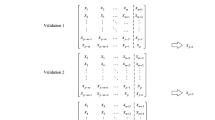Abstract
This paper addresses problem of predicting direction and magnitude of movement of currency pairs in the foreign exchange market. The study uses Support Vector Machine with a novel approach for input data and trading strategy. The input data contain technical indicators generated from currency price data (i.e., open, high, low and close prices) and representation of these technical indicators as trend deterministic signals. The input data are also dynamically adapted to each trading day with genetic algorithm. The study incorporates a currency strength-biased trading strategy which selects the best pair to trade from the available set of currencies and is an improvement over the previous work. The accuracy of the prediction models are tested across several different sets of technical indicators and currency pair sets, spanning 5 years of historical data from 2010 to 2015. The experimental results suggest that using trend deterministic technical indicator signals mixed with raw data improves overall performance and dynamically adapting the input data to each trading period results in increased profits. Results also show that using a strength-biased trading strategy among a set of currency pair increases the overall prediction accuracy and profits of the models.







Similar content being viewed by others
References
A List of Forex Trading Terms (2015) http://www.investopedia.com/categories/forex.asp. 17 Dec 2015
A List of Technical Indicators (2015) http://www.investopedia.com/active-trading/technical-indicators/. Accessed on 13 Dec 2015
Anasataskis L, Mort N (2009) Exchange rate forecasting using a combined parametric and nonparametric self-organising modelling approach. Expert Syst Appl 1:12001–12011
Bahrepour M, Akbarzadeh M, Yaghoobi M, Naghibi S (2011) An adaptive ordered fuzzy time series with application to FOREX. Expert Syst Appl 1:475–485
Box GEP, Jenkins GM (1976) Time series analysis: forecasting and control. Holden-Day, San Francisco
Brown DP, Robert HJ (1989) On technical analysis. Rev Financ Stud 2:527–551
Chen MY, Chen K, Chiang H, Huang H, Huang M (2007) Comparing extended classifier system and genetic programming for financial forecasting: an empirical study. Soft Comput 1:1173–1183
Cheung Y, Chinn MD, Pascual AG (2005) Empirical exchange rate models of the nineties: are they fit to survive? J Int Money Finance 24:1150–1175
Cortes C, Vapnik V (1995) Support-vector networks. Mach Learn 1:20
Davis L (1991) Handbook of genetic algorithms. Van Nostrand Reinhold, New York
Determination of the Euro Conversion Rate (2015) https://www.ecb.europa.eu/press/pr/date/1998/html/pr981231_2.en.html. Accessed on 13 Dec 2015
Genetic Strategy Optimization (2016) http://www.multicharts.com/genetic-strategy-optimization/. Accessed on 14 Jan 2016
Gupta AR, Ingle VR, Gaikwad MA (2012) LS-SVM parameter optimization using genetic algorithm to improve fault classification of power transformer. Int J Eng Res Appl 1:1806–1809
Ijegwa D, Rebecca O, Olusegun F, Isaac O (2014) A predictive stock market technical analysis using fuzzy logic. Comput Inf Sci 7(3):1–17
Jung HG, Yoon JP, Kim J (2007) Genetic algorithm based optimization of SVM based pedestrian classifier. ITC-CSCC 1:833–834
Kampouridis M, Otero FEB (2015) Heuristic procedures for improving the predictability of a genetic programming financial forecasting algorithm. Soft Comput 1:1–16
Kamruzzaman J, Sarker R (2003) Forecasting of currency exchange rates using ANN: a case study. IEEE Int Conf Neural Netw Signal Process 1:793–797
Khemchandani R, Jayadeva Chandra S (2009) Regularized least squares fuzzy support vector regression for financial time series forecasting. Expert Syst Appl 1:132–138
Korol T (2014) A fuzzy logic model for forecasting exchange rates. Knowl Based Syst 1:49–60
Leitch G, Tanner JE (1991) Economic forecast evaluation: profits versus the conventional error measures. Am Econ Rev 1:580–590
Lu C, Lee T, Chiu C (2009) Financial time series forecasting using independent component analysis and support vector regression. Decis Support Syst 1:115–125
Major Forex Currencies (2015) http://www.investopedia.com/university/forex-currencies/. Accessed on 17 Aug 2015
Meffert K (2014) JGAP—Java Genetic Algorithms and Genetic Programming Package. http://jgap.sf.net
Moosa I, Burns K (2014) The unbeatable random walk in exchange rate forecasting reality or myth? J Macroecon 1:69–81
Nesreen A, Atiya A, Gayar N, Shishiny H (2010) An empirical comparison of machine learning models for time series forecasting. Econ Rev 1:594–621
Pang S, Song L, Kasabov N (2011) Correlation-aided support vector regression for forex time series prediction. Neural Comput Appl 1:1193–1203
Patel J, Shah S, Thakkar P, Kotecha K (2015) Predicting stock and stock price index movement using trend deterministic data preparation and machine learning techniques. Expert Syst Appl 1:259–268
Shahjalal M, Sultana A, Mitra KN, Khan K (2012) Implementation of fuzzy rule based technical indicator in share market. Int J Appl Econ Finance 6:53–63
Shen F, Chao J, Zhao J (2015) Forecasting exchange rate using deep belief networks and conjugate gradient method. Neurocomputing 1:243–253
Smithsonian Agreement (2015) http://www.federalreservehistory.org/Events/DetailView/34. Accessed on 17 Aug 2015
Tick-by-Tick Real-Time and Historical Market Rates (2016) http://www.truefx.com/. Accessed on 14 Jan 2016
Trading Strategy Optimization with Genetic Algorithms (2016) http://www.tradecision.com/product/trading_systems/strategy_optimization.htm. Accessed on 14 Jan 2016
Villa S, Stella F (2012) A continuous time bayesian network classifier for intraday FX Prediction. Quantitative Finance, pp 1-20
Wang S, Yu L, Lai K, Huang W (2007) Developing and assessing an intelligent forex rolling forecasting and trading decision support system for online e-service. Int J Intell Syst 1:475–499
Yao J, Tan C (2000) A case study on using neural networks to perform technical forecasting of forex. Neurocomputing 1:79–98
Zhang P (2003) Time series forecasting using a hybrid ARIMA and neural network model. Neurocomputing 1:159–175
Zhiqiang G, Huaiqing W, Quan L (2013) Financial time series forecasting using LPP and SVM optimized by PSO. Soft Comput 1:805–818
Author information
Authors and Affiliations
Corresponding author
Ethics declarations
Conflict of interest
The authors declare that they have no conflict of interest.
Ethical approval
This article does not contain any studies with human participants or animals performed by any of the authors.
Additional information
Communicated by V. Loia.
Appendix
Appendix
1.1 Formulae regarding computation of precision, recall, accuracy and F-measure
Rights and permissions
About this article
Cite this article
Özorhan, M.O., Toroslu, İ.H. & Şehitoğlu, O.T. A strength-biased prediction model for forecasting exchange rates using support vector machines and genetic algorithms. Soft Comput 21, 6653–6671 (2017). https://doi.org/10.1007/s00500-016-2216-9
Published:
Issue Date:
DOI: https://doi.org/10.1007/s00500-016-2216-9




